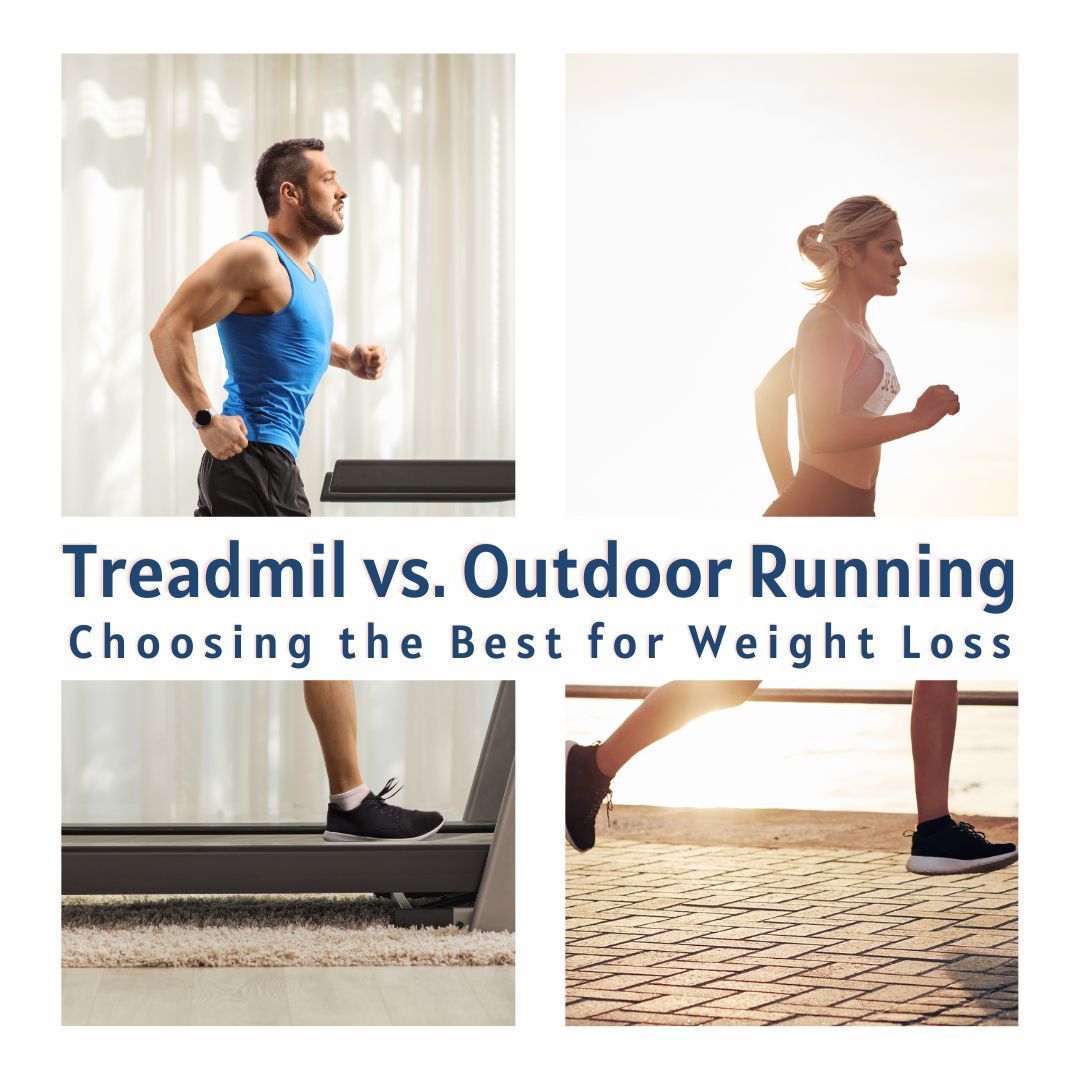Treadmill vs. Outdoor Running: Choosing the Best for Weight Loss

Are you on a mission to shed those extra pounds and achieve your weight loss goals? If so, you've likely encountered numerous recommendations, workout plans, and dieting strategies. Among the most debated options for burning calories and achieving weight loss are running on a treadmill and outdoor running. In this comprehensive guide, we'll delve into the merits and drawbacks of each, and how they can align with your weight loss journey, diet plan, and calorie deficit goals.
Running for Weight Loss
The Significance of Running
Running stands out as an exceptional cardiovascular exercise that can help you burn calories, boost your metabolism, and enhance your overall fitness. It's an adaptable activity suitable for various fitness levels and weight loss aspirations, making it a favored choice among those aiming to shed unwanted pounds.
Grasping the Fundamentals of Weight Loss
Before diving into the treadmill vs. outdoor running debate, it's vital to grasp the basics of weight loss. Weight loss transpires when you create a calorie deficit, meaning you expend more calories than you consume. This can be achieved through a combination of dietary adjustments and physical exercise.
Treadmill Running
Advantages of Treadmill Running
- Controlled Environment: Treadmills offer a controlled and consistent environment for running. You can customize the speed, incline, and duration of your workout to match your fitness level and objectives.
- Weather Independence: Treadmill running is impervious to weather conditions. Whether it's sweltering hot or pouring rain outside, you can consistently engage in your treadmill workout.
- Safety: Treadmills provide a secure option for running, especially during dimly lit hours or when outdoor running entails risks.
- Data and Metrics: Many contemporary treadmills feature various metrics and tracking capabilities to monitor your progress, encompassing metrics such as calories burned, distance covered, and heart rate.
Challenges of Treadmill Running
- Monotony: A portion of individuals finds treadmill running monotonous, as it involves running in a stationary position without the dynamic scenery and diverse terrain encountered in outdoor running.
- Absence of Fresh Air: Indoor air quality may not match the freshness of the outdoor environment, and some people miss the invigorating outdoor air.
Outdoor Running
Benefits of Outdoor Running
- Variety: Outdoor running presents an array of routes, terrains, and picturesque views, making each run a distinct and engaging experience.
- Vitamin D: Exposure to sunlight during outdoor running can facilitate the production of vitamin D, which is essential for overall well-being.
- Mental Well-being: Many individuals discover outdoor running to be mentally invigorating, serving as an effective stress reducer and mood enhancer.
- Calorie Expenditure: Running against wind resistance and traversing uneven terrain can potentially result in greater calorie expenditure compared to treadmill running.
Challenges of Outdoor Running
- Weather Dependency: Outdoor running is contingent on weather conditions. Extreme heat, cold, or precipitation can disrupt your running routine.
- Safety Considerations: Depending on your location, outdoor running may pose safety concerns, such as traffic hazards and irregular terrain.
- Tracking Metrics: Monitoring metrics such as heart rate and distance can be less precise when compared to the controlled environment of a treadmill.
Integrating Running with Diet Plans
The Role of Diet in Weight Loss
While exercise plays a pivotal role in burning calories and enhancing fitness, it's imperative to acknowledge that diet holds primary significance in weight loss. Running alone will not yield significant weight loss outcomes if your dietary habits remain unaddressed. Achieving a balanced diet that results in a calorie deficit is key.
Combining Running with Diet Plans
To optimize weight loss, contemplate incorporating your running regimen with a well-balanced diet plan. Here are some recommendations:
- Calorie Deficit: Calculate your daily caloric requirements and target a moderate calorie deficit (typically 500-1000 calories less than maintenance) for consistent and sustainable weight loss.
- Nutritional Balance: Concentrate on a diet rich in whole foods, encompassing lean proteins, fruits, vegetables, whole grains, and healthy fats. Restrict excessive consumption of processed foods, sugary beverages, and empty-calorie items.
- Meal Timing: Ponder when you eat in conjunction with your runs. Pre-run snacks or meals can provide an energy boost, while post-run nutrition plays a vital role in recovery.
- Hydration: Ensure adequate hydration, both during your runs and throughout the day, to support metabolism and overall well-being.
- Seek Professional Guidance: If you harbor doubts regarding the most suitable diet plan for your weight loss objectives, seek consultation with a registered dietitian or nutrition expert.
The Psychology of Running
Motivation and Consistency
Weight loss and fitness goals are not solely about the physical aspects but also entail a significant psychological component. Maintaining motivation and consistency can be challenging for many individuals. Here are some psychological factors to consider:
- Set Achievable Goals: Establish realistic, attainable milestones for your weight loss journey. Celebrate your achievements along the way.
- Stay Accountable: Share your goals with a friend or family member who can provide support and hold you accountable.
- Incorporate Variety: To combat the monotony associated with long-term running routines, introduce variety into your workouts. Alternate between treadmill and outdoor running, try different routes, or join a running group.
- Mindful Running: Practice mindfulness during your runs. Pay attention to your body, your breathing, and the environment around you. Mindful running can enhance your connection with the activity and reduce stress.
Choosing the Right Footwear
The Importance of Proper Running Shoes
Whether you opt for treadmill or outdoor running, selecting the right footwear is crucial. Ill-fitting or inappropriate shoes can lead to discomfort, pain, and even injury. Here's how to choose the right running shoes:
- Visit a Specialty Store: Head to a specialty running store where experts can assess your gait, foot type, and running style. They can recommend shoes tailored to your specific needs.
- Try Before You Buy: Always try on running shoes before making a purchase. Walk around the store, jog on a treadmill if available, and ensure a proper fit.
- Replace Regularly: Running shoes have a lifespan. Depending on your mileage, you may need to replace them every 300-500 miles or when they show signs of wear and tear.
Staying Hydrated and Nourished
Nutrition and Hydration Tips for Runners
Running, whether indoors or outdoors, demands proper nutrition and hydration. Staying nourished and hydrated enhances performance and aids in recovery. Here's what you need to know:
- Pre-Run Nutrition: Consume a light, balanced meal or snack 1-2 hours before your run. This can provide the energy needed for your workout.
- During Your Run: For longer runs, consider carrying water or a sports drink to stay hydrated. Some runners also use energy gels or chews for sustained energy.
- Post-Run Recovery: After your run, refuel with a balanced meal containing carbohydrates, protein, and healthy fats. This aids in muscle recovery and replenishing glycogen stores.
Injury Prevention and Recovery
Safeguarding Your Running Journey
Injuries are a potential setback in any running regimen. Whether you're on the treadmill or outdoors, it's essential to prioritize injury prevention and recovery. Here are some injury prevention strategies:
- Warm-Up and Cool Down: Prior to running, perform dynamic warm-up exercises to prepare your muscles. After your run, engage in static stretches to improve flexibility.
- Strength Training: Incorporate strength training into your fitness routine to build muscle and support your joints.
- Listen to Your Body: Pay attention to any signs of discomfort or pain. Rest when needed and seek medical advice if an injury occurs.
- Cross-Training: Mix running with other forms of exercise, such as swimming or cycling, to reduce the risk of overuse injuries.
Long-Term Fitness and Weight Maintenance
Beyond Weight Loss
While weight loss might be your initial goal, it's essential to look beyond the numbers on the scale. Running can be a lifelong pursuit that extends beyond weight loss. Consider these aspects for long-term fitness:
- Set New Goals: Once you've achieved your weight loss goal, set new challenges for yourself, such as running longer distances, participating in races, or improving your speed.
- Lifestyle Integration: Make running a part of your lifestyle. Invite friends to join you, explore new running routes, and engage in the running community.
- Dietary Sustainability: Transition from a weight loss diet to a sustainable, balanced eating pattern that supports your long-term health and fitness goals.
In the treadmill vs. outdoor running debate, there exists no universally applicable solution. Both options offer their advantages and limitations, with the final choice hinging on personal preferences, objectives, and environmental factors.
Whether you embrace the controlled environment of a treadmill or the dynamic allure of outdoor running, running is a powerful tool in your weight loss journey and broader fitness goals. Keep in mind that effective weight loss is a combination of creating a calorie deficit through diet and exercise, staying motivated, and nurturing a positive relationship with running as a lifelong pursuit.
With your running shoes laced up, you possess the power to select your path—whether on the treadmill or amidst the great outdoors—and embark on a journey toward a healthier, more vibrant version of yourself. Remember that the most crucial aspect of your fitness journey is to enjoy the process and sustain your long-term commitment to well-being.


